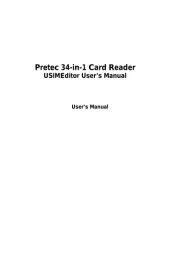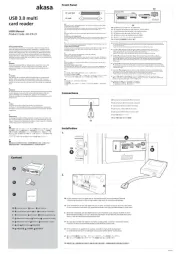SanDisk Imagemate Reader USB 3.0 Handleiding
SanDisk
Geheugenkaartlezer
Imagemate Reader USB 3.0
Bekijk gratis de handleiding van SanDisk Imagemate Reader USB 3.0 (6 pagina’s), behorend tot de categorie Geheugenkaartlezer. Deze gids werd als nuttig beoordeeld door 22 mensen en kreeg gemiddeld 3.9 sterren uit 11.5 reviews. Heb je een vraag over SanDisk Imagemate Reader USB 3.0 of wil je andere gebruikers van dit product iets vragen? Stel een vraag
Pagina 1/6

ImageMate® USB 2.0
Reader/Writer
User Guide
The Multi-Function Hi-Speed USB 2.0 Reader/Writer for:
SDDR-189 All-in-One Reader/Writer:
CompactFlash®, SD™, SDHC™, miniSD™, miniSDHC™, microSD™, microSDHC™, MultiMediaCard™, MMC ™ plus ,
MMC ™, RS-MMC™, RS-MMC Dual Voltage, Memory Stick™, Memory Stick PRO™, Memory Stick Duo™, mobile
Memory Stick PRO Duo™, Memory Stick PRO-HG Duo™, xD™, xD Type M™, xD Type M+™, xD Type H™
SDDR-199 Multi-Card Reader/Writer:
SD, SDHC, MultiMediaCard, MMC , MMC , plus mobile
RS-MMC, RS-MMC Dual Voltage, Memory Stick,
Memory Stick PRO and xD & xD Type M & H
Download the Transfer Button Application from www.sandisk.com/imagemate
Magnet in stand has no impact on the data stored on a card that is inserted in the reader.
Congratulations
Congratulations on your purchase of the ImageMate USB 2.0 Reader/Writer. With a simple USB cable, the ImageMate Reader/
Writer can quickly move multimedia data and large files to and from your computer. The ImageMate Reader/Writer supports both
Hi-Speed USB 2.0 and Full Speed USB 1.1 and is backward compatible with USB 1.1 ports. The ImageMate Reader/Writer is easy to
use. You don’t have to turn off or restart your computer to attach it, and you don’t need to open your computer for any reason. And
since the ImageMate Reader/Writer is powered by the USB connection, an AC/DC power adapter is not required. In most cases, all
you need to do is plug the ImageMate Reader/Writer in and get going.
System Requirements
Connection
USB 2.0 port for Hi-Speed data transfer (or USB 1.1 port for Full Speed data transfer)
Operating System Support
• Windows
– Windows 2000
– Windows XP
– Windows Vista
• Macintosh
– Mac OS 10.3
– Mac OS 10.4
– Mac OS 10.5
Unpacking Package Contents
• ImageMate Reader/Writer (storage card not included)
• Reader stand
• USB cable
• Quick Start Guide
English

Checking
1. Unpack the packaging. Make sure you have everything listed in the “Unpacking Package Contents.”
2. Check your system requirements. Refer to SYSTEM REQUIREMENTS or the outside of the packaging.
3. Locate the USB port on your computer. See UNDERSTANDING.
Understanding
What’s a USB port?
The Universal Serial Bus (USB) port is an easy way to connect a new device like the ImageMate Reader/Writer to your computer.
Connecting a device to the USB port doesn’t require that you open your computer to install an add-in card or set complicated
switches. You just plug it in and get started.
How do I find the USB port?
The USB ports are often located on the front or back of your PC, or on a USB hub.
On a laptop computer or a Macintosh, the USB port may be located on the side. The USB port looks like this:
What is the difference between Hi-Speed USB 2.0 and Full Speed USB 1.1?
Hi-Speed USB 2.0 supports the transfer of data up to 480 megabits per second (Mbps), and Full Speed USB 1.1 supports data
transfer up to 12 Mbps. Hi-Speed USB 2.0 provides a dramatic improvement in data transfer performance compared to Full Speed
USB 1.1. USB 2.0 is backward compatible with USB-1.1 ports. The ImageMate Reader/Writer supports both USB 2.0 and USB 1.1.
Connecting
The ImageMate Reader/Writer can be used with and without the metal stand. To attach the reader, put the
stand on a flat surface and position the reader on the stand as illustrated. To detach the reader, hold the
stand down with one hand and pull up the reader with the other hand.
Connecting the ImageMate Reader/Writer to the USB port is simple. You don’t need to turn off or restart
your computer when attaching the ImageMate Reader/Writer. Since the ImageMate Reader/Writer is
powered by the USB connection, an AC/DC power adapter is not needed.
When the ImageMate Reader/Writer is connected for the first time, your computer may display a message
that the device is being installed (may vary slightly depending on your operating system).
It is not necessary to install software on your computer to transfer files with the ImageMate Reader/Writer.
But there are two free utilities available that will enhance the experience of your ImageMate Reader/Writer:
• TransferButtonApplication
The Transfer Button on top of the ImageMate Reader/Writer lets you launch your favorite (photo) program or web site with the
touch of a button.
• DriveLetterApplication
The Drive Letter application makes it easy to find the right drive letter for the card that you want to access.
Go to www.sandisk.com/imagemate to learn more and follow the instructions on how to download, install and use the software.
Windows Disk Icons
• ImageMate Multi-Card Reader/Writer:
When you connect the ImageMate Multi-Card Reader/Writer on a Windows operating system, one removable disk icon
representing the card slot shows in My Computer with newly assigned drive letter.
• ImageMate All-in-One Reader/Writer:
When you connect the ImageMate All-in-One Reader/Writer on a Windows operating system, four removable disk icons
representing the card slots show in My Computer with newly assigned drive letters:
– 1st new removable drive: microSD/microSDHC
– 2nd new removable drive: SD/SDHC/miniSD/miniSDHC/MultiMediaCard/MMC /MMC /RS-MMC/ plus mobile
RS-MMC Dual Voltage
– 3rd new removable drive: Memory Stick/Memory Stick PRO/Memory Stick Duo/Memory Stick PRO Duo/
Memory Stick PRO-HG Duo/xD/xD Type M, M+ & H
– 4th new removable drive: CompactFlash

When the Drive Letter application has been installed (see above), drive letter icon(s) will only show up when a card is inserted. Also
the generic icon at each drive letter will be replaced by an icon representing the main card format(s) of each card slot.
Macintosh Disk Icons
When you connect the ImageMate Reader/Writer on a Macintosh operating system, removable disk icons labeled ‘no name’
representing the card slots show on desktop when a card is inserted.
When the Drive Letter application has been installed (see above), the generic disk icon will be replaced by an icon representing the
main card format(s) of the occupied slot(s).
Using
Inserting Card
To install a card into the ImageMate Reader/Writer’s card slot, insert the connector end of the card with the label facing to the
right (when placed on the stand).
Do not force the card into the slot.
LEDActivity
Each card slot has a blue LED:
• The LED turns on when a card is properly inserted
• The LED blinks when data is transferred from or to the card
If the LED is not on, check to make sure the ImageMate Reader/Writer is connected and the card is inserted properly.
NEVER remove the card when the LED is FLASHING.
Using it on a PC with the transfer button application
1. Go to www.sandisk.com/imagemate to download the ImageMate software and installation instructions for model
SDDR-189/SDDR-199.
2. Install the software according to the instructions.
3. After the software has been installed successfully and you have selected the application to launch every time you press the
button, press the button and access the files on the card through your favorite application.
Using it on a PC without the ImageMate software being installed
Here is the way to create a Folder on your Desktop and Copy and Paste your photos to it.
1. How to create a FOLDER on your Desktop
A. Place your mouse pointer somewhere on the Desktop but not on an icon.
B. Click once with the mouse button, move your mouse pointer over then click RIGHT NEW FOLDER LEFT with the mouse button.
C. This will create a on your Desktop. At this time you can name anything you like, i.e. My Pictures or Photos, by NEWFOLDER
typing the name in. When you are finished typing press the key on your keyboard. Now the folder name is saved.ENTER
2. How to copy and paste your photos into a folder
A. Double click on the icon “My Computer”.
B. Double click on the removable disk drive (for the ImageMate Reader/Writer), i.e. F: or G: or maybe E: Now you should see a
DCIM folder (that stands for Digital Camera Images).
C. Double click on the DCIM folder. Now you should see your camera folder, i.e. 100Olymp or 100Canon or 100Fuji.
D. Double click on the camera folder. Now you should see your pictures or picture file names (depending on what Operating
System you are using).
E. Go up to the menu bar where it says “EDIT” and click on “SELECTALL”. You will see all your pictures HIGHLIGHTED.
F. Go back to “EDIT” and now click “COPY”. Close or minimize this window.
G. Double click on the folder you created on your Desktop, go to “EDIT” “PASTE” then click and you should see the pictures
being copied to the folder.
H. To View your Pictures Double click on the File name and the Picture will open up.
Using it on Macintosh without the ImageMate software being installed
1. Connect the ImageMate Reader/Writer to the USB port on your Mac (do not connect to Monitor or Keyboard).
2. To transfer files place a card into the Reader/Writer unit. A new drive will appear on your desktop called “untitled”.
3. Drag and drop files to and from the new drive as you would to any other disk or folder.
Product specificaties
| Merk: | SanDisk |
| Categorie: | Geheugenkaartlezer |
| Model: | Imagemate Reader USB 3.0 |
Heb je hulp nodig?
Als je hulp nodig hebt met SanDisk Imagemate Reader USB 3.0 stel dan hieronder een vraag en andere gebruikers zullen je antwoorden
Handleiding Geheugenkaartlezer SanDisk

6 Mei 2023

20 April 2023
Handleiding Geheugenkaartlezer
- SumUp
- Urban Factory
- Act
- Konig
- Sitecom
- Hikvision
- Arctic Cooling
- Sigma
- Equip
- Green House
- Nedis
- OneSpan
- Buffalo
- Approx
- Revoltec
Nieuwste handleidingen voor Geheugenkaartlezer

6 Juni 2025

11 Mei 2025

27 Februari 2025

27 Februari 2025

20 Februari 2025

12 Februari 2025

1 December 2024

1 December 2024

19 November 2024

30 September 2024